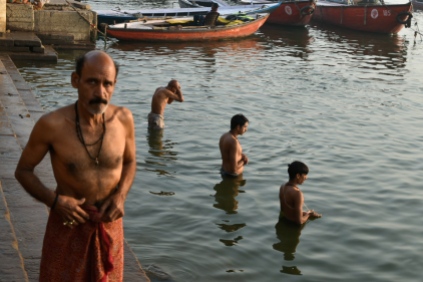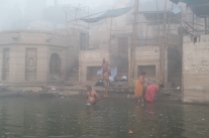It is with very mixed feelings that our time in India draws to a close. Different it certainly is! One minute we’re loving the chaotic bustle and vibrancy together with the curious, smiling, friendly people who crowd around us when we stop. At the next we can’t stand the incessant head drumming noise, crushing crowds and appalling drivers. Not to mention the persistent touts, swindlers and beggars at many tourist attractions and sacred sites we’ve visited as we’ve laced our way across a strip of India.
Of course, more than any other country we’ve visited, there’s a feeling of “well we haven’t seen X”, but that’s why it’s called a subcontinent. Probably two years would be needed to explore the whole country, whereas we’ve trundled across it in three months, riding only half the time.
We’ve almost enjoy seeing the cattle, goats, dogs, less frequently pigs, ever present in the streets, or the pesky monkeys swinging overhead. All up for a vegetable stall raid if a merchant has dropped their guard. The cattle nonchalantly block the road or a passageway. Gid had a narrow escape meeting a bull who was ‘hoofing the turf’. A moment or two after he squeezed past, it hoofed again before tossing a 20kg cement bag up into the air where it got caught on overhead wires, trickling its contents in a shower back down to earth. Thus we learnt to recognise a bull in this mood, and avoid it! Most, however, are very tolerant of being moved along with a quick ‘ha!’ or simply squeezed past.
The mess and muck we’ve grown used to as well as the frequently present stench of ‘street’ toilets where well-dressed Indian men will only approach the general area before adding to the problem. No idea where the ladies go when they’re out in town! Amusingly, in Bodhgaya there’s a street sign – Please use toilet. It was truly incongruous to see jewelled bare feet squelching through slime and muck after an unseasonal down pour. But we got used to it, although you won’t see us in flipflops!
It’s hard not to be disturbed by the visible poverty. It’s far more evident than in, say, Kyrgyzstan, despite the countries having similar per capita incomes. It probably testifies to India’s immense inequalities. However, Indians generally seem in very good spirits. It seems in England, everyone’s miserable because they are feel short of money and time. Can’t see why India should follow that model, and it doesn’t.
We encountered begging in tourist areas, with a peak at the Buddhist pilgrimage sites. The Hindu holy men are supposed to be a cultural fixture, and sustained only by those around them, but they seem to make a beeline for tourists. Having seen one old guy score basically a day’s wages in one hit, from four Thai pilgrims, it’s not hard to see why. Urchins often put their hands out, and in Bodhgaya and Varanasi there was real medieval stump-waving, but it’s impossible to work out what’s real – locals usually advise not to give. I passed a lady walking by the roadside in the country, and she lifted a hand to me: “Rupee, rupee”; yet she had about $400 worth of silver bangles on that arm.
In many ways India has seemed to be in a time warp. It’s been quite stunning to see so many ancient machines and techniques still in use where ox carts and man power still dominate. In the country, there are lots of new tractors, but apart from that everything looks pretty archaic. We passed the sugar cane harvest in Madhya Pradesh, a prosperous state. The factories filled the skyline, chimneys billowing out thick black smoke, but it was scythes and ox carts out in the fields that fed the mills. In towns, half the market’s spread out on the floor, and cobblers, tailors and puncture repairers have plenty of work, while roadside corn grinders and milk boilers are busy too. Aside from the animal hauled transport, some of the stuff on the roads seems crazily archaic. The tuk tuk is a fine piece of 1940s minimal engineering (sez Gid), but there are still motor tricycles running, that appear barely any advance on Carl Benz’s original 1886 tricycle, with the machinery (belts, chains) taking up nearly a cubic metre. But it’s juxtaposed with sleek new Suzukis, mobile phones and satellite dishes together with, adverts for ECGs and medical labs, and in the papers, India’s just tested a new, longer range, nuclear missile.
‘We’re not like your country, we’re relaxed.‘ ‘Without it it wouldn’t be India’, are a couple the claims I’ve overheard. And no one follows any of the laws that are passed for the safety of your citizens, I could add. ‘No, we don’t follow any rules,’ one lad chuckled as he agreed. Road traffic regulations are blatantly ignored resulting in the worst driving we’ve experienced and leading to one of the highest death tolls on roads in the world, as well as being a topic of frequent debate in the newspapers. We’ll make a separate posting for Indian drivers!
India is widely known as the world’s biggest democracy. But curiously, it feels more like a police state than anywhere else we’ve been. Not only are there heavily armed police all over the place, but there are rules, rules, rules prohibiting all sorts of things. No wonder Indians generally don’t attend to them. Passports are needed more than anywhere else, and numerous forms to be filled. Unlike everywhere else though, we can read the newspapers, and see the very public, and venal, politics (oddly, it reminds Gid of Irish newspapers and politics, dominated by the crookedness of the politicians). There are hugely snarled up checkpoints and taxation at the borders between states. We only realised while here, how separate the states are, and of course, with their own politics, perhaps like the USA. Maybe that’s one reason there’s an impression that the Delhi government says “jump”, and …it doesn’t work out the way the “Centre” intended (planned would be too strong a word, perhaps). It does feel as if the country is tied in a bureaucratic Gordian knot of its own devising, although some might comment that the British helped devise some of it!
The British often claim to be an exceptionally tolerant nation. But Indians seem much more so. They put up with – smile through – what seem to us the most appalling behaviour and difficulties.
Cricket, India’s unofficial national game, has filled the tiniest of crevices in passage ways and the busiest of road sides – fielders posed on the other side of the streaming traffic – to spare fields, parks and the ‘promenade’ of the Ganges, where yet again fielding was an issue. With the high levels of enthusiasm and skill displayed, it’s no wonder they’ve just thrashed England here, in the latest Test series… And One Day… And T20. Probably a good job we never managed to get to any of the matches.
Just before we flew in, the Indian government abruptly invalidated the two larger main banknotes, and prohibited cash withdrawals larger than roughly £23: “demonetisation”. Result, utter chaos in this cash economy. Enormous queues at the few ATMs that got stocked with new notes. Like other tourists we spent days hunting hotels that take (foreign) cards, working ATMs, and queueing for endless 2000 Rupee withdrawals. And the banks simply lapped up the flat rate charges they levy when people make small transactions abroad, like a 10% tax. So it caused a lot of hassle and wasted time, we saw others in real distress, and a lot of Indians really fell foul of it as it killed the casual labour economy dead in some places. That plus the impact of the Brexit vote on the pound’s value, made a real difference to our budget here. Unfortunately we only worked that out after we’d stripped Rajasthan of souvenirs and posted them home on Concorde.
The other money issue is the swindling. Led by the India government, which charges foreigners typically ten times what Indians pay to see sites, there’s a culture of gouging in some sectors. It’s also common to quote one price at the start of a transaction, then try to charge a lot more with unexpected add-ons. There seems to be complete tolerance of swindlers who claim to be collecting for charitable purposes, but are not. There are different amounts of swindling in different sectors: 100% of boatmen, 50% of auto rickshaw drivers, whereas most shopkeepers seem pretty honest.
There’s generosity too. Free tea stops, the odd free meal…. Nice people about, especially away from the tourist trail.
We’ve seen spectacular sights in India, and found the present and past both fascinating. Much of the culture, to us has seemed, unique and other worldly. There were frustrations and dropouts with all the electrics, but most days we had WiFi or phone data, and rather wobbly electricity was available every night. The winter weather is nice, guesthouses plentiful and cheap, our tums have managed ok so far, and the roads are mostly flat and smooth. And yet….. It’s felt a struggle being here. Has India beaten us, or does surviving count as a win?

Bimbetka – how many years BC?

Above the rock paintings at Adamgarh

Pilgrims at Maheshwar

Varanasi at dawn

Talent at Bodhgaya

Cricket everywhere. Pretty good pitch, this.

Takes two to grind a blade.

Barely an advance on Karl Benz’s original, but his packaging was better.




































































































































